The Supermicro X9DRL-EF is a solution to fit two Intel Xeon E5-2600 (V1 or V2) series processors into a low cost ATX form factor. The benefit of this approach is that the motherboard can be utilized in short-depth chassis. The vast majority of dual LGA2011 solutions are Extended ATX form factors are larger which allows for more PCB area for components, but also costs more. Today we review the Supermicro X9DRL-EF to see just how much functionality their engineers can fit into a small package.
Test Configuration
For this test we were limited to 130w processors as the motherboard supports up to 130w TDP Intel Xeon E5 processors. We utilized the fastest 32nm LGA2011 “server” processors available right now just to generate a bit more heat. We loaded up a healthy dose of RAM and more SSDs to the mix.
- CPUs: 2x Intel Xeon E5-2690 CPUs
- Motherboard: Supermicro X9DRL-EF
- Memory: 8x Samsung 16GB 1600MHz DDR3 ECC RDIMMs
- SSDs: 2x Samsung 840 Pro 256GB 4x SanDisk Extreme II 240GB
- Operating System: Ubuntu 12.04 LTS and Windows Server 2012
The major caveat here is that one does need to take a special look at cooling with this type of configuration as there are many parts to generate heat.
Supermicro X9DRL-EF Overview
One of the most notable things about the Supermicro X9DRL-EF is its form factor. It utilizes ATX mounting points but is ever so slightly larger measuring 12×10 inches instead of the standard 12×9.6 inches for ATX motherboards. In the vast majority of applications this still works fine but it should be noted. The other major feature is that in this small form factor there are sockets for eight DIMMs (four for each processor) and two LGA 2011 sockets. The sockets use the standard cooling form factor instead of the narrow ILM we reviewed previously.
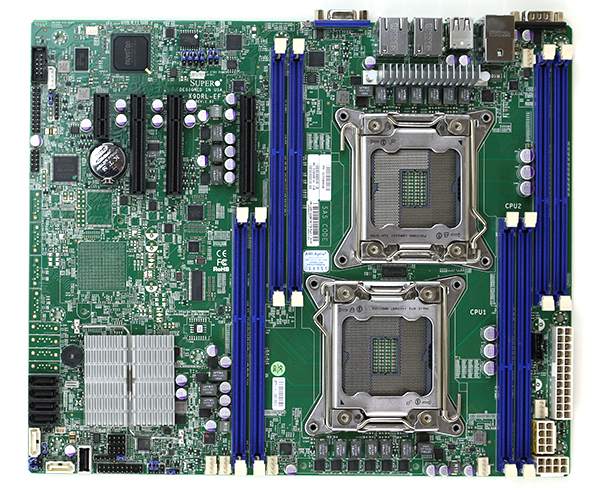
To achieve this dense configuration, the processors are lined up just slightly offset from one another. Likewise the DIMM slots are slightly offset and overlapping. By offering only four DIMMs per processor and using this configuration, both processors are able to be accommodated with four DIMMs to match the Intel Xeon E5-2600 series quad channel memory controller.
One major area that needs to be addressed with this type of design is that when using high TDP processors, cooling becomes a major consideration. We used two active coolers but in standard server configurations air is going to be heated by the first processors cooling exhaust and then pass directly into the heatsink of the second cooler. Some chassis with lower cooling capabilities will have difficulty cooling this arrangement so a user does need to be mindful of this when selecting cooling setups.
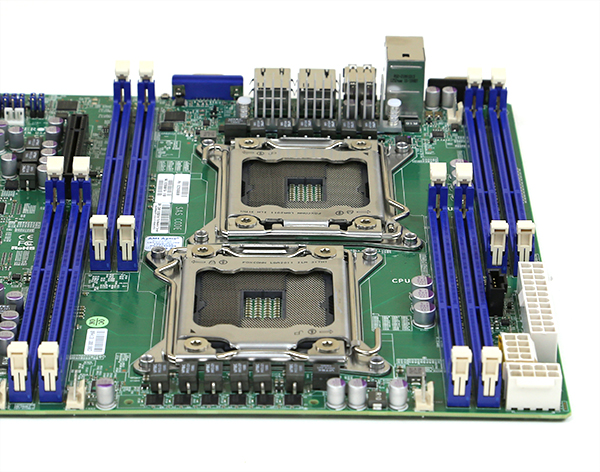
Another point here is that dual processors require two 8-pin CPU power connectors along with the 24-pin ATX power connector. Given the small form factor, these need to be fit tightly in the top corner of the motherboard.
In terms of expansion slots, the Supermicro X9DRL-EF has 2x PCIe 3.0 x8 slots, 1x PCIe 2.0 x4 slot in an x8 physical slot and a PCIe 2.0 x1 slot. This is certainly many PCIe lanes less than the dual Intel Xeon E5-2600 series processors provide. In many applications these will be installed in 1U or 2U short depth chassis such as the short-depth Supermicro SC813MFTQ-441C) where only 1-2 slots at most will be utilized.
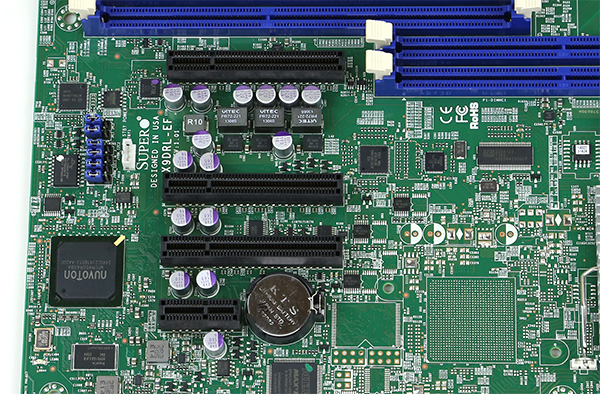
In terms of storage connectivity the motherboard has two SATA III 6.0gbps ports. It also supports four SATA II 3.0gbps ports. Next to these one can also see an internal Type-A USB header which is commonly used for internal USB boot drives or application keys.
There is also clear pin-outs for a square chip not present on the X9DRL-EF and eight 7-pin connectors not present. The answer lies in the sister board the X9DRL-7F which has an onboard LSI SAS2208 8-port SAS controller. It is a common practice in the industry to have variations on the same design as we see here to lower overall platform costs.
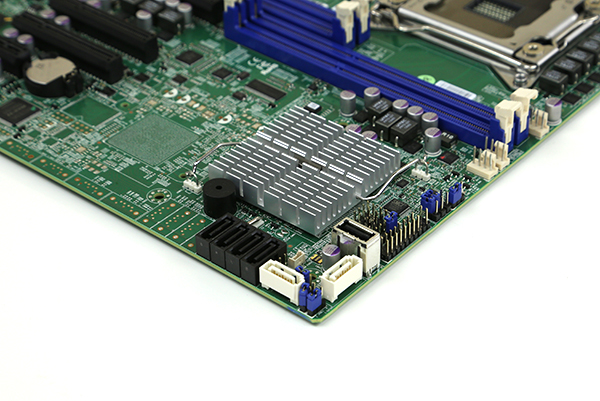
In terms of the rear I/O, the Supermicro X9DRL-EF has a fairly standard array that we see on many Supermciro X9 and X10 series configurations. There are legacy analog VGA and serial ports. In between those two ports are four USB 2.0 ports which can be used to quickly connect extra peripherals. Additionally there is a RJ-45 port for the dedicated Realtek controlled IPMI 2.0 port. Along the base of the PCB there are two Intel i210 gigabit network controllers which are the newer replacement for Intel’s popular 82574L gigabit Ethernet controllers.

All told, the Supermicro X9DRL-EF is designed to be a compact, low cost, dual processor platform.
Supermciro IPMI 2.0 Remote Management and Monitoring
Supermicro’s IPMI and KVM-over-IP as described a few times on this site, allows for a lot of deployment flexibility. Things such as fan speeds, chassis intrusion sensors, thermal sensors, and etc. can be monitored remotely. Alerts can be setup to notify the admins of issues. Beyond this, the BMC solution also allows for remote power control. You can do remote power up, power down, and reset of the server in the event that it becomes unresponsive. In fact, the test system has never had a keyboard, mouse, CD/DVD ROM, or monitor hooked up to it, even after multiple BIOS tweaks and operating system/ hypervisor installations.
Another important feature is the ability to remotely mount CD images and floppy images to the machine over the dedicated management Ethernet controller. This keeps maintenance traffic off of the primary Intel NICs. At the same time it removes the need for an optical disk to be connected to the Supermicro motherboard. Combined with the onboard USB 2.0 header, mounting OS installation or recovery images remotely is a very simple affair.
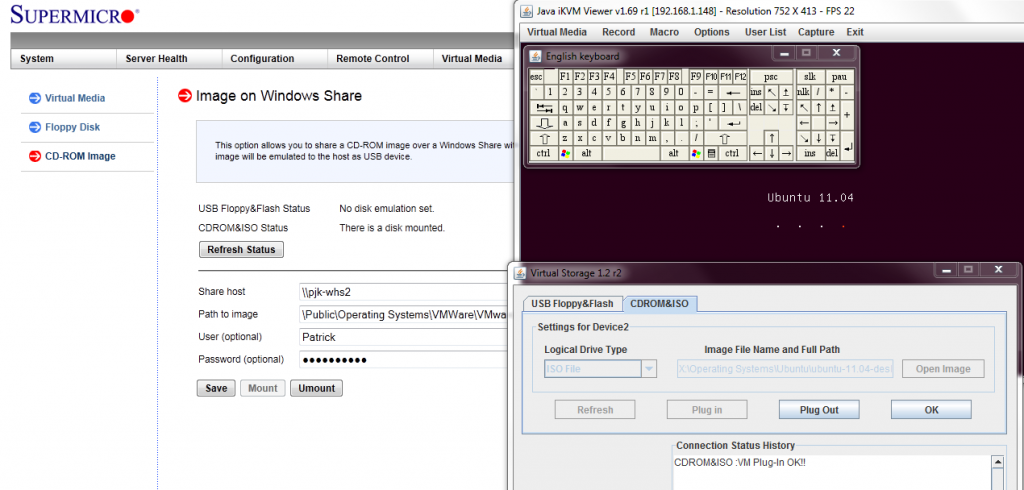
In combination with the baseboard level management features just described, KVM-over-IP features of the Supermicro board are not to be underestimated. One can log on to the server using a web browser with Java platform support to administer the server. Or one can go through Supermicro’s IPMIview software and have remote console capabilities, with mouse support included. Oftentimes, users opine that shell access is enough to troubleshoot. However this BMC level access to the remote system allows one to immediately see things such as a hung and incomplete boot process, frozen servers, as well as manage motherboard and add-in card BIOS remotely. Supermicro provides a well featured WebGUI to its IPMI management system for each server.
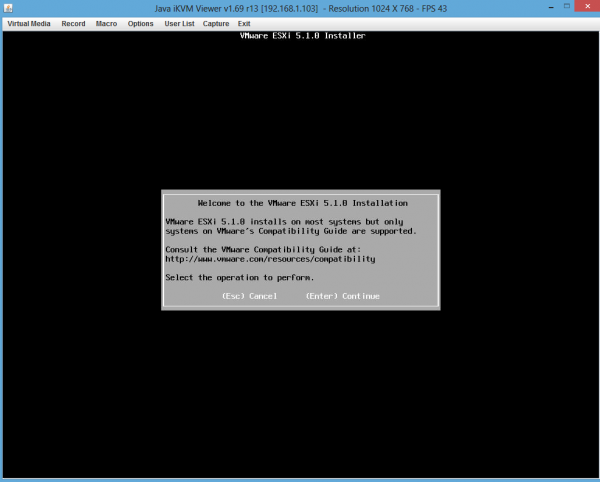
IPMI 2.0 features, including the KVM-over-IP features are essential for a server-class motherboard unless one has an external KVM-over-IP unit and a network addressable power source. For users with redundant PSUs, as will be the most common use case with this motherboard, remotely toggling on/ off multiple power supply ports across multiple PDUs can be difficult making the motherboard option preferred.
Conclusion
The Supermicro X9DRL-EF must make some understandable trade-offs in order to shrink the platform size. It accomplishes this fairly well with its street pricing falling 15-20% below that of its competition making it a compelling low cost solution. Another important factor is the fact that it can be installed in virtually any chassis from large rackmount units down to short depth 1U chassis and pedestal servers like the SC732 chassis I used in a recent Tom’s Hardware piece. Overall the Supermicro X9DRL-EF is a solid low cost 2P motherboard able to power a majority of systems.





I get this because it is inexpensive to build.
Actually the X9DRL-7F features an LSI 2208 without cache, so it acts somewhat like a LSI 2308. The big plus of using the LSI 2208 in this configuration is the ability to read the HDD health status off the drives, a feature the LSI 2308 lacks. But given it’s lack of cache, the 2208 only support RAID 0,1,10 in this configuration.
Patrick, can we expect a review with eg. a Xeon E5-2620 v2 soon?
Really curious how this compares to the v1 series and the E3-1200v3 series.
Peter – we do not have Xeon E5-2620 V2. Only the E5-2697 V2’s. I know, this is a rough problem to have. It is on the list to solution in the next few weeks though.
Mmm… Would be nice to have a e5-2630v2 though (fastest one in the 80W enveloppe). In my opinion this is a sweet spot processor (if you compare price/performance) with a price a normal home user would be able to pay. Is this possible?
Compared to a E3-1230v3 it would give a nice view on price/performance/power. Almost nowhere this data is found anyway, beside your site :)
@Peter:
The choice between E3-1230v3 and E5-2600v2 isn’t entirely based on price/performance/watt. More differences between the two families are based on IO and ram density.
The E3 can only take 4 dimms of dual rank ram or 8 total ranks of ram. The E5-2600v2 is a dual socket config CPU with 4 channels each handling 2 dimms of quad ranks max. So Dual E5-2600v2s can have a total of 32 ranks of ram!
Another difference is PCI-e lanes. Dual E5 can have 80 lanes. Perfect for 4 GPUs or Even 8 GPUs(7990) with PCI-e splitters.
So if you don’t need 32 ranks of ram or 80 lanes of PCI-e, go with the Xeon E3v3.